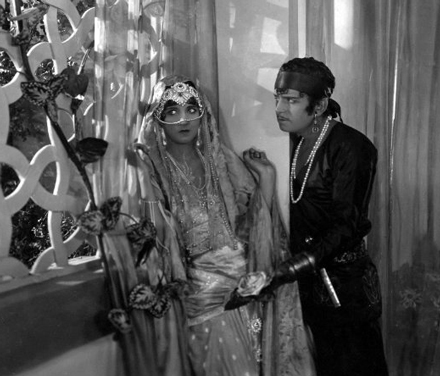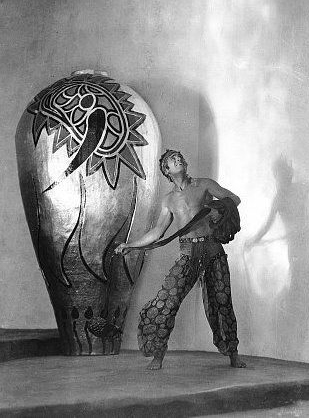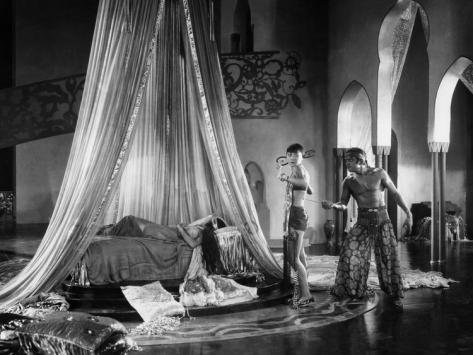
 |
|
|
|
Every age has its wonder entertainments, and 1924's The Thief of Bagdad transported audiences to a new level of imaginative fantasy. It had the biggest star of the era in a production that dwarfed anything anyone had ever seen: a towering Arab city, magical domains in dark grottoes, under the sea and in the sky. Movies once convinced people that Hollywood could create entire environments out of nothing, and this picture tops all previous efforts. It has sets bigger than those in Intolerance and costumed crowd scenes to rival the enormous Italian spectacles of the day. What's more, the picture is packed with elaborate special effects, many of which still have the power to impress. 
The wonder man behind this all was Douglas Fairbanks, a true superstar who projected an image of vigor, virtue and robust vitality to an international audience. Clearly running away with his own ambitions, Fairbanks poured unheard-of resources into his giant film, which was shot square in the middle of today's West Hollywood. The credited director is the talented Raoul Walsh, but we're given to understand that Fairbanks called the shots. The story is adapted from several ideas from 1001 Arabian Knights. The happy Thief (Fairbanks) amuses himself by helping himself to purses and stolen food in Bagdad's market; he hides his loot in a secret cave at the bottom of a well, where his "Evil Associate" (Snitz Edwards) keeps watch. The Thief scoffs at the faithful, mocking the wise and kindly Holy Man (Charles Belcher). Taking up the dangerous challenge of burgling the enormous palace of The Caliph (Brandon Hurst), The Thief sneaks past the guards but is captivated by the sight of the Princess (Julianne Johnston). Three rich Princes have come to compete for the hand of the Caliph's daughter, including a conniving Mongol (Sojin), whose spy-Slave (Anna May Wong) is in place as the Princess's handmaiden. The Thief disguises himself as a fourth Prince and before he is captured, gets close enough to the Princess to profess his love. Stalling for time, The Princess asks her father to send her suitors on a seven-moon search for treasure, with the one who brings back the most incredible gift to be her husband. The thief has escaped with a terrible whipping, but his heart is even more deeply wounded. The Holy Man has the answer ... if he is to win the Princess, he must become a Prince. 
Douglas Fairbanks stated that The Thief of Bagdad's story was utterly simple. In truth, it captures a storybook purity that today's movies have lost. The film's satisfying motto is "Happiness must be earned", even though The Thief would more properly state, "I get by with a little help from my friends." What makes the difference is The Thief's / Fairbanks boundless optimism and energy. He takes nothing seriously and laughs at life until love makes him feel unworthy. A little Holy counseling and The Thief is dedicating himself to feats of daring and danger, on a hunt to collect various magic items. Before you can say Legend of Zelda, the film is overflowing with wonders: a magic carpet, a golden apple of the sun, an all-seeing eye, a cloak of invisibility, a winged horse. The topper is a magic item that can do just about anything its bearer desires, including conjure an entire army up out of nowhere. The Princess is sweet, the various Arab muckety-mucks amusing (one of them is actor Noble Johnson) and the villain quite interesting. The Mongol Prince's aspiration to wed the Princess is but step one in his dastardly plan to conquer Bagdad. Anna May Wong's treacherous spy feeds him inside information. She even poisons the Princess at his command, and helps him sneak a commando force into the Caliph's palace, disguised as gift-bearers. The last act of The Thief of Bagdad is one exciting or miraculous scene after another. Some critics prefer Douglas Fairbanks' earlier modern-day adventures to his twenties' costume epics, but this dazzler still takes people's heads off. Simply put, the production's overall design and execution -- sets, costumes, lighting, special effects -- are coordinated so tightly that the illusion of grandeur is complete. Even now, the impression is of 'being there', not being on a movie set. Fairbanks' costume designer was the fussy future director Mitchell Leisen. Say what you will about a perfectionist who insisted on the finest fabrics, etc., Leisen's costumes are really sophisticated. The Thief goes about in patterned pants and a headband for most of the picture, showcasing the dazzling smile and incredible physique (he'd just turned 40) that made him a dream lover for a generation of women. The costumes for the Princess and her court are neither robes atop robes nor ersatz lingerie, but something that might make a woman feel like a princess. Every serf and soldier has something interesting to wear. The Mongol Prince's commandos sport impressive battle helmets, and halberds appropriate for harvesting cocoanuts. 
The film's main designer is the amazing William Cameron Menzies, whose work as a Production Designer (I'm given to understand that the title was invented for him) and later director is unmistakable in the classics Gone With The Wind, Things to Come, Kings Row, Address Unknown and Invaders from Mars. More or less starting from the top of the industry, Menzies constructed gigantic structures on the West Hollywood film lot, and then augmented them with expert glass paintings. The palace wall (a giant row of curious panels) and the palace interiors are architectural wonders that glow with light and have enough shiny floors to employ a squadron of wax & polishers. Filmed dry-for wet, an undersea kingdom is all curves and flourishes; other structures look vaguely Moderne, but not quite Art Deco. Most importantly, Menzies gives The Thief of Bagdad a sense of enormous scale. The Thief enters the palace by climbing a vast web of ivy snaking up a wall that must be forty feet high. Many shots hold wide to show characters moving like ants amid structures too big for Mount Olympus. 1 Yes, if you look hard enough the wires on the fabled Flying Carpet are visible, but we also find out that the main actors rode that thing even when suspended by a crane high above the set, with no net below. Even more impressive are the optical effects for the cloak of invisibility. We see parts of people not covered by the cloak, and sometimes a whirring blur indicating where the 'invisible' Thief is. There is no degradation of the image, no telltale matte fringe, nothing. It's all apparently a perfect in-camera multiple exposure. 
The Thief of Bagdad is a long movie but never a boring one. We never tire of watching Douglas Fairbanks bounce across a row of oversized cisterns, scale tall walls or drop three times his height and land on his feet. His one 'stylized' acting gimmick is to mime an odd grabbing motion, whenever he sees something he wants to steal. The storybook characters hold up quite well despite not being multi-dimensional. Anna May Wong's spy never reveals a conscience, and neither does her master The Mongol Prince, who has a beggar killed just to see if the Golden Apple will revive him (shades of Jay Robinson, thirty years later). A favorite moment shows the Mongol villain, realizing he's beaten, calmly ordering his own decapitation. But his Number One interrupts -- Wait! there's still hope! In The Thief of Bagdad even the bad guys can hope for the best. The Cohen Media Group's Blu-ray of The Thief of Bagdad is a beautiful transfer of a major restoration job. The film had never been allowed to deteriorate but when I saw it in the 70s the print available was pretty ragged. Today's technology returns it to a lustrous B&W, with nary an unstable frame or an unsteady splice. We really appreciate the artful inter-titles, for not spoiling the magic spell with topical humor or shooting clever winks to the audience. The movie is quite long but rewarding on all counts. The music is a beautifully recorded score by Carl Davis, conducting the Philharmonia Orchestra. The themes are mix of Davis' own work and familiar music by Rimsky-Korsakov. 2 The Thief of Bagdad was the final screening item at 2012's TCM Film Festival, at the Egyptian Theater where it had played almost 90 years before. Hosting the evening was author Jeffrey Vance, who contributed the extras for this disc. Vance is good at sifting legend from facts. His commentary gives one a vivid picture of Hollywood and Fairbanks "in the day". Also included is a fascinating annotated gallery of behind-the-scenes photographs and classy still art from the movie, showing the colossal sets, the beautiful costume work and the dangerous-looking rig for the flying carpet special effect. The Cohen Group controls a large number of pictures, including the former Rohauer Library, and we're looking forward to more quality releases. One picture they have rights for is Fritz Lang's Hangmen Also Die! Were a better-quality and complete version of that picture reissued, I feel that it would rightly be elevated to front-rank status in Lang's career.
On a scale of Excellent, Good, Fair, and Poor,
The Thief of Bagdad Blu-ray rates:
Footnotes:
1. A big video monitor will be a help in appreciating these sets. Like Metropolis or King Kong, on a large screen The Thief of Bagdad looks bigger than big.
2. I have to add here, that back at UCLA Film School in the early '70s we were often privileged to hear the great organist Gaylord Carter play with our screenings in Melnitz. I think one of the shows I saw with his accompaniment was The Thief of Bagdad ... we loved him and always gave him a standing ovation. Carter had played for silent movies as a young man, and if we were callow in some ways, UCLA's Bob Epstein and David Bradley certainly gave us an appreciation of silent film art.
Reviews on the Savant main site have additional credits information and are often updated and annotated with footnotes, reader input and graphics.
Review Staff | About DVD Talk | Newsletter Subscribe | Join DVD Talk Forum |
| ||||||||||||||||||